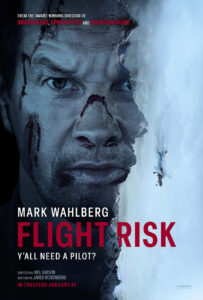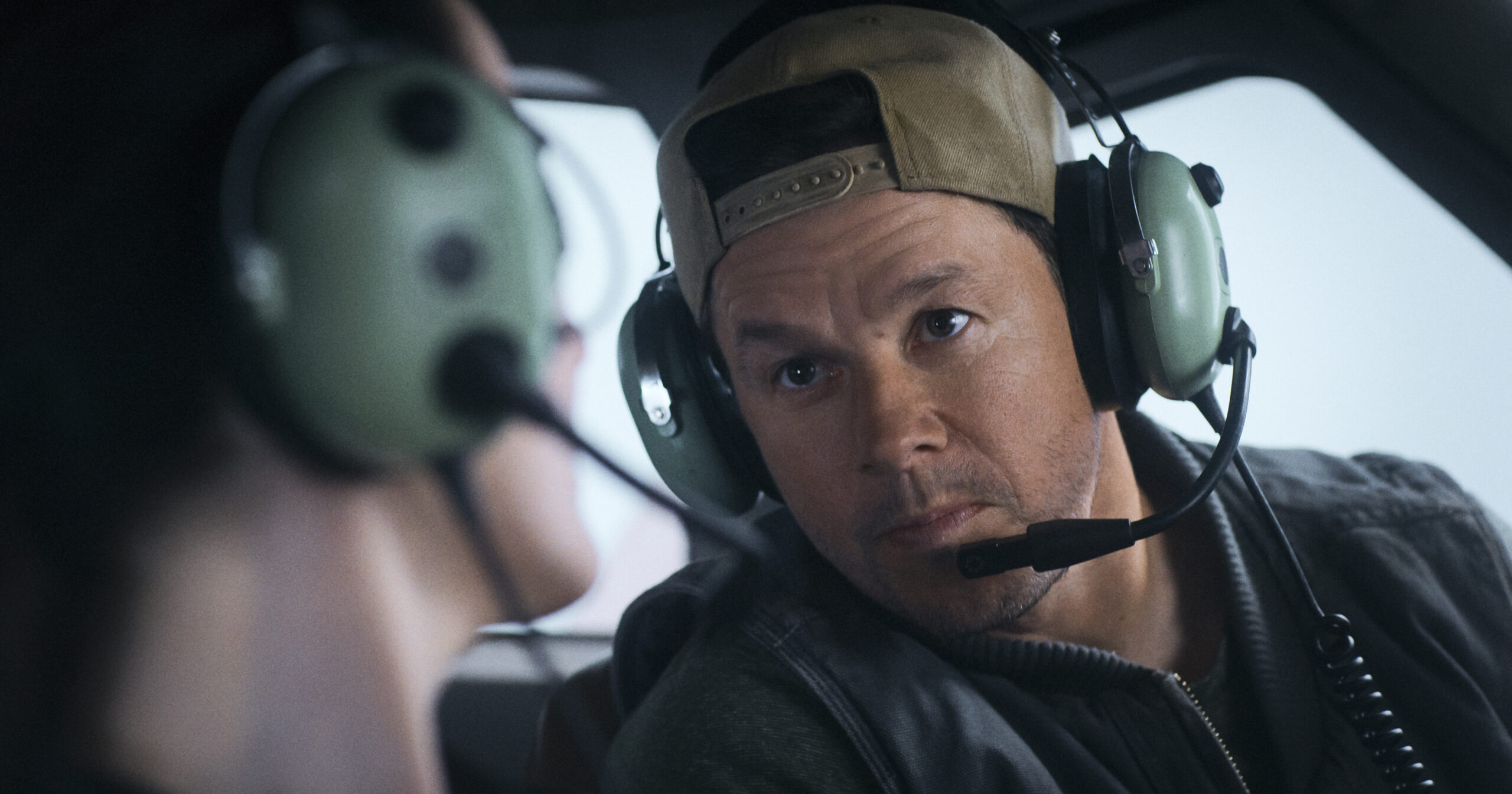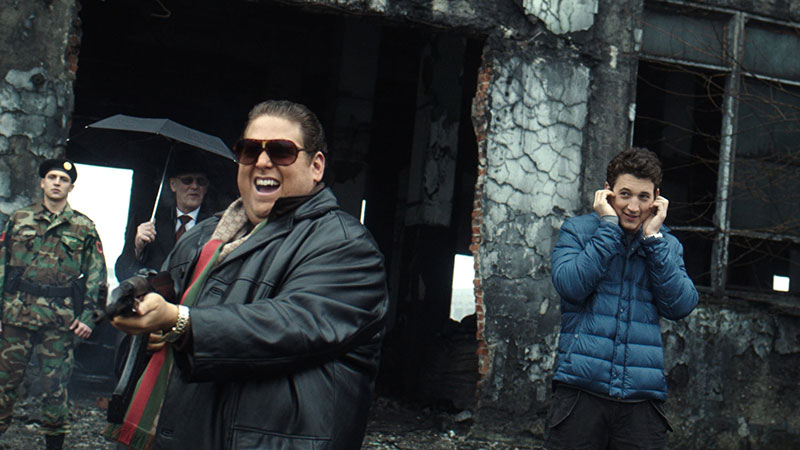The suspense thriller “Flight Risk,” which opened in theaters exactly one month ago on January 24, 2025, represents a unique technical and creative achievement in filmmaking. Directed by Academy Award-winner Mel Gibson and starring Mark Wahlberg, Michelle Dockery, and Topher Grace, the film delivers edge-of-your-seat tension within the claustrophobic confines of a small aircraft flying over the majestic Alaskan wilderness.

A thrilling and propulsive mix of high-octane action and psychological warfare
aboard a small aircraft as it soars above the majestic vistas of the Alaskan terrain, FLIGHT
RISK opens as mob accountant Winston (Grace) is captured by U.S. Deputy Marshal
Madolyn (Dockery) at a seedy motel.
The Concept: Suspense at 10,000 Feet
“Flight Risk” follows U.S. Deputy Marshal Madolyn Harris (Dockery) as she transports fugitive Winston (Grace), a mob accountant turned government witness, on a flight over Alaska. Their pilot, Daryl (Wahlberg), initially appears to be a folksy veteran airman but is soon revealed to be a hitman tasked with ensuring Winston never makes it to testify.
The screenplay by Jared Rosenberg drew inspiration from the writer’s personal experiences. “Growing up, relatives would take us up in these small, single-engine aircraft,” Rosenberg explains. “That sense of flight is unlike anything you get on a commercial jet: it is tactile and analog. You feel every bump and air pocket—the rivets rattle—and when you turn, the entire world seems to shift around you.“
Producers John Fox and John Davis of Davis Entertainment discovered Rosenberg’s spec script and immediately recognized its potential. “We fell in love with the script. It felt very producible, but also very original,” says Davis. When Mel Gibson’s agent reached out, they sent him the script, and he came on board to direct.
The Volume: Creating Alaska in Las Vegas
One of the most impressive aspects of “Flight Risk” was the filming technique. Rather than attempting to shoot in an actual airborne plane—which would have been logistically impossible—the production team utilized cutting-edge technology to create a convincing illusion.
The majority of filming took place on a soundstage in Las Vegas, where an immersive environment known as “The Volume” was installed. This innovative setup featured 1,830 LED panels arranged in a 270-degree display capable of playback at 24k horizontal resolution. The Cessna Grand Caravan airplane was mounted on a 10-foot gimbal that could simulate realistic flight movements.
“The Volume helped to open up our world,” explains director of photography Johnny Derango. “It emphasizes how small our characters and plane are, in context to the magnificent world around them.“
To capture the breathtaking Alaskan vistas that would be displayed on The Volume, visual effects supervisor Michael Ralla and Derango developed a specialized camera rig. “There were five 8K Red V-Raptor cameras in portrait mode for height, with a 6th facing down,” Derango describes. “The rig was then hung from a 30-foot long line on a helicopter flown by world-renowned helicopter pilot Fred North, an expert in acquiring aerial images.” North flew through mountainous terrain to capture the visuals that would later be played back on The Volume.
Gibson appreciated the technical achievement: “The imagery was so detailed, the plates we shot were amazing, and we projected them onto The Volume wall in incredibly ultra-high definition. It looks totally real.“
Topher Grace, who plays Winston, was similarly impressed during filming: “My naked eye thought we were flying.“
The Plane: A Character of Its Own
Production designer David Meyer approached the aircraft itself as another character in the film. “We wanted the largest bush plane we could find, and the Grand Caravan did the trick,” he explains. The interior dimensions—five and a half feet wide and four and a half feet tall—created natural challenges, with actors and crew constantly in a crouched position.
Meyer deliberately gave the plane a menacing quality. “I wanted it to look mean inside,” he recounts. “So, we came up with a yellow-ish color, but dulled it down, and aged it out.“
The plane had to be highly modular to accommodate filming. “David Meyer understood that the plane had to be able to yank the windows out and take the nose off,” Gibson notes. “In short, he had to pull the plane apart and put it back together again. It was a lot of engineering to pull off and was nothing short of miraculous.“
The Cast: Creating Chemistry in Close Quarters
The film’s success rests heavily on the performances of its three main stars, who spent weeks filming in the confined space of the airplane set. Mark Wahlberg took on the role of the psychopathic Daryl, a significant departure from his typical heroic characters.
“I read the script and fell in love with it,” Wahlberg confirms. “Also, I hadn’t played a bad guy in almost 30 years,” referring to his role in the 1996 thriller “Fear.” Wahlberg embraced the chance to surprise audiences: “They’re going to think, ‘Here comes Mark to do something to save the day, but nope. Fifteen minutes into the film, you realize this is not what you thought it was going to be.“
For the role, Wahlberg even altered his appearance dramatically. “Yes, I’m bald in this; we chopped off my hair, in the front and back. There’s no bald cap or wig. Everything is real there.“
Michelle Dockery, best known for her role as Lady Mary Crawley in “Downton Abbey,” took on the character of U.S. Deputy Marshal Madolyn Harris. To prepare, Dockery had access to a federal U.S. Marshal as a technical consultant, though she says, “I drew more inspiration from law enforcement characters in film and television series I had admired.” She cites Sarah Lancashire’s work as a police sergeant in “Happy Valley” as particularly influential.
Dockery appreciated the character’s depth: “Madolyn really has heart. There’s a past there, and she’s trying to rectify a mistake that had turned out horribly. Madolyn is trying to prove she’s capable and reliable in the field.“
Topher Grace notes that the film’s confined setting created unique opportunities: “You spend a lot of time with Winston, Madolyn, and Daryl, and I don’t think I’ve ever played a role where I had the opportunity to do so much in a single film.”
The close quarters fostered real bonding among the cast. “In this confined space, we got to know each other, quickly!” Wahlberg remarks.
The Stunts: Fighting in Flight
The action sequences presented another challenge—choreographing realistic fights within the tiny airplane. “We were capturing some pretty brutal exchanges within that small area,” Gibson confirms. “That kind of intense action is difficult even with lots of space, but you’re working within such a limited area, when you get it, well, it really works.“
Stunt coordinator David Barrett worked closely with the actors, particularly with Dockery, who had to perform many physically demanding scenes. The gimbal added another layer of complexity, creating a sense of genuine peril. “We’re all 30 feet up in the air, atop the gimbal, and it felt like we were ascending or diving,” Grace recalls. “Those reactions you see from me on screen are real!“
The Vision: Balancing Claustrophobia and Epic Scope
The film’s unique appeal lies in its balance of tight, claustrophobic tension within the plane and the vast, breathtaking Alaskan landscapes outside. “So, while ‘Flight Risk’ is set inside a small plane, it feels open, and the vistas are magnificent. The scope is huge,” Gibson explains.
This juxtaposition was intentional, according to Derango: “There were times we would go from a super wide exterior shot, and then come in on a tight closeup. I love the juxtaposition of transitioning from the vastness of the world around them to the micro-focused interior and drama.“
Writer Jared Rosenberg believes this creates a singular theatrical experience: “This is a story that takes place in real-time, confining strangers together in a small plane, and so seeing the movie in theaters—with strangers—creates an environment for the audience that mimics the experience of the characters on screen.“
Now a month into its theatrical run, “Flight Risk” continues to generate buzz for its innovative filming techniques, stellar cast, and high-stakes premise. As Mark Wahlberg predicted before release: “They’re going to scream, laugh, cover their eyes, yell at the screen, and cheer. FLIGHT RISK is a wild ride meant to be experienced in theaters.“




